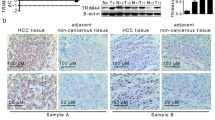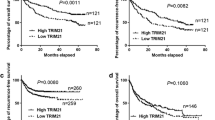Abstract
Hepatocellular carcinoma (HCC) is a major type of primary liver cancer and the sixth most prevalent human malignancies worldwide. However, the molecular mechanisms underlying hepatocarcinogenesis remain unclear. For HCC patients, there is not only a lack of effective therapeutic targets but also a lack of predictive or prognostic biomarkers. In this article, we reported that TRIM32 was obviously upregulated in HCC tumor tissues and HCC cell lines. Its expression patterns were positively correlated with histological grade, tumor sizes, and HBsAg of HCC patients. TRIM32 expression was a significant predictor for the overall survival time of HCC patients. Moreover, the overexpression of TRIM32 in cells accelerated the G1-S phase transition, promoted cell proliferation rates, and induced the resistance of HCC patients to oxaliplatin. All these findings suggest that TRIM32 might play important roles in the hepatocarcinogenesis. TRIM32 could be a novel direction to explore the mechanism underlying HCC pathogenesis.





Similar content being viewed by others
References
Zhang JB, Zhang B, Guo L, Lin ZH, Li XQ, Guo K, Sun HC, Ye QH (2015) Peritumoral Cbl is a strong independent prognostic marker after curative resection of hepatocellular carcinoma. Oncotarget 6:40223–40234. doi:10.18632/oncotarget.5540
Wang FS, Fan JG, Zhang Z, Gao B, Wang HY (2014) The global burden of liver disease: the major impact of China. Hepatology 60:2099–2108. doi:10.1002/hep.27406
Weissman AM (1997) Regulating protein degradation by ubiquitination. Immunol Today 18:189–198
Reymond A, Meroni G, Fantozzi A, Merla G, Cairo S, Luzi L, Riganelli D, Zanaria E, Messali S, Cainarca S, Guffanti A, Minucci S, Pelicci PG, Ballabio A (2001) The tripartite motif family identifies cell compartments. EMBO J 20:2140–2151. doi:10.1093/emboj/20.9.2140
Schwamborn JC, Berezikov E, Knoblich JA (2009) The TRIM-NHL protein TRIM32 activates microRNAs and prevents self-renewal in mouse neural progenitors. Cell 136:913–925. doi:10.1016/j.cell.2008.12.024
Albor A, El-Hizawi S, Horn EJ, Laederich M, Frosk P, Wrogemann K, Kulesz-Martin M (2006) The interaction of Piasy with Trim32, an E3-ubiquitin ligase mutated in limb-girdle muscular dystrophy type 2H, promotes Piasy degradation and regulates UVB-induced keratinocyte apoptosis through NFkappaB. J Biol Chem 281:25850–25866. doi:10.1074/jbc.M601655200
Ozato K, Shin DM, Chang TH, Morse HC 3rd (2008) TRIM family proteins and their emerging roles in innate immunity. Nat Rev Immunol 8:849–860. doi:10.1038/nri2413
Slack FJ, Ruvkun G (1998) A novel repeat domain that is often associated with RING finger and B-box motifs. Trends Biochem Sci 23:474–475
Kano S, Miyajima N, Fukuda S, Hatakeyama S (2008) Tripartite motif protein 32 facilitates cell growth and migration via degradation of Abl-interactor 2. Cancer Res 68:5572–5580. doi:10.1158/0008-5472.CAN-07-6231
Liu J, Zhang C, Wang XL, Ly P, Belyi V, Xu-Monette ZY, Young KH, Hu W, Feng Z (2014) E3 ubiquitin ligase TRIM32 negatively regulates tumor suppressor p53 to promote tumorigenesis. Cell Death Differ 21:1792–1804. doi:10.1038/cdd.2014.121
Horn EJ, Albor A, Liu Y, El-Hizawi S, Vanderbeek GE, Babcock M, Bowden GT, Hennings H, Lozano G, Weinberg WC, Kulesz-Martin M (2004) RING protein Trim32 associated with skin carcinogenesis has anti-apoptotic and E3-ubiquitin ligase properties. Carcinogenesis 25:157–167. doi:10.1093/carcin/bgh003
Albor A, Kulesz-Martin M (2007) Novel initiation genes in squamous cell carcinomagenesis: a role for substrate-specific ubiquitylation in the control of cell survival. Mol Carcinog 46:585–590. doi:10.1002/mc.20344
Louafi S, Boige V, Ducreux M, Bonyhay L, Mansourbakht T, de Baere T, Asnacios A, Hannoun L, Poynard T, Taieb J (2007) Gemcitabine plus oxaliplatin (GEMOX) in patients with advanced hepatocellular carcinoma (HCC): results of a phase II study. Cancer 109:1384–1390. doi:10.1002/cncr.22532
Ganten TM, Haas TL, Sykora J, Stahl H, Sprick MR, Fas SC, Krueger A, Weigand MA, Grosse-Wilde A, Stremmel W, Krammer PH, Walczak H (2004) Enhanced caspase-8 recruitment to and activation at the DISC is critical for sensitisation of human hepatocellular carcinoma cells to TRAIL-induced apoptosis by chemotherapeutic drugs. Cell Death Differ 11(Suppl 1):S86–S96. doi:10.1038/sj.cdd.4401437
Hatakeyama S (2011) TRIM proteins and cancer. Nat Rev Cancer 11:792–804. doi:10.1038/nrc3139
Ding Q, He D, He K, Zhang Q, Tang M, Dai J, Lv H, Wang X, Xiang G, Yu H (2015) Downregulation of TRIM21 contributes to hepatocellular carcinoma carcinogenesis and indicates poor prognosis of cancers. Tumour Biol 36:8761–8772. doi:10.1007/s13277-015-3572-2
Izumi H, Kaneko Y (2014) Trim32 facilitates degradation of MYCN on spindle poles and induces asymmetric cell division in human neuroblastoma cells. Cancer Res 74:5620–5630. doi:10.1158/0008-5472.CAN-14-0169
Cohen S, Lee D, Zhai B, Gygi SP, Goldberg AL (2014) Trim32 reduces PI3 K-Akt-FoxO signaling in muscle atrophy by promoting plakoglobin-PI3 K dissociation. J Cell Biol 204:747–758. doi:10.1083/jcb.201304167
Zhang J, Hu MM, Wang YY, Shu HB (2012) TRIM32 protein modulates type I interferon induction and cellular antiviral response by targeting MITA/STING protein for K63-linked ubiquitination. J Biol Chem 287:28646–28655. doi:10.1074/jbc.M112.362608
Meroni G, Diez-Roux G (2005) TRIM/RBCC, a novel class of ‘single protein RING finger’ E3 ubiquitin ligases. BioEssays 27:1147–1157. doi:10.1002/bies.20304
Funding
This study was funded by the Natural Youth Foundation of China (Grant numbers 81502072, 81401985), National Natural Science Foundation of China (Grant number 81472272), The Administration of Science and Technology of Nantong (Grant number MS22015062).
Author information
Authors and Affiliations
Corresponding authors
Ethics declarations
Conflict of interest
None.
Additional information
Xiaopeng Cui and Zhipeng Lin equally contributed to this work.
Electronic supplementary material
Below is the link to the electronic supplementary material.
Rights and permissions
About this article
Cite this article
Cui, X., Lin, Z., Chen, Y. et al. Upregulated TRIM32 correlates with enhanced cell proliferation and poor prognosis in hepatocellular carcinoma. Mol Cell Biochem 421, 127–137 (2016). https://doi.org/10.1007/s11010-016-2793-z
Received:
Accepted:
Published:
Issue Date:
DOI: https://doi.org/10.1007/s11010-016-2793-z




